
“The History & Science of Kimchi” by Hae Jung Cho
The Culinary Historians of San Diego present “The History and Science of Kimchi,” featuring Hae Jung Cho, at 10:30 a.m. June 15, in the Neil Morgan Auditorium of the San Diego Central Library, 330 Park Boulevard, San Diego. The event is free and open to the public. A tasting will follow.
Cho will describe the national food of Korea and the many ways it is prepared and served at each meal. She will also explore kimchi’s mysteries — for example, why it is buried in the ground — and demonstrate how to make the most popular type of this most popular food.
10:30am – 12:00pm
Saturday, June 15, 2019
Neil Morgan Auditorium
San Diego Central Library
330 Park Blvd.
San Diego, CA 92102
About Hae Jung Cho
Hae Jung Cho has been a professional cook since 2003. Trained as a master food preserver, Hae Jung has been teaching people how to make kimchi and other ferments since 2011, and has a Facebook group called “Hae Jung’s Kimchi Club.” She is a founding and executive committee member of the Slow Food Preservers Los Angeles and a newbie gardener at the Crenshaw Community Garden.
Photos
-

“The History & Science of Kimchi” by Hae Jung Cho
-
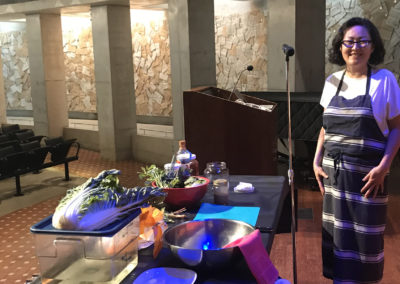
Hae Jung Cho
-
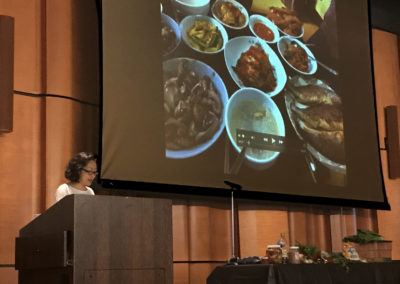
Hae Jung Cho presents “The History & Science of Kimchi”
-

Kimchi tastings after the presentation
-
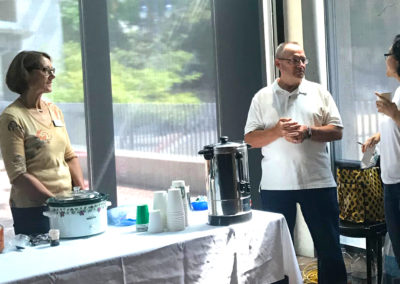
Tastings follow presentations
-
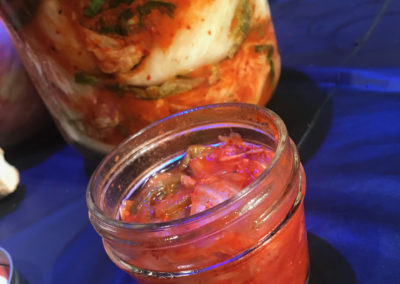
Samples of Kimchi
Recipes
Poggi Kimchi (Whole Napa Cabbage Kimchi)
By Hae Jung Cho, from the June 15, 2019 meeting
Ingredients
1 head Napa cabbage (approximately 5 lbs.)
1 cup coarse salt (usually sea salt, but kosher is fine too)
Water to cover (about 4 quarts)
2 ounces Korean red mustard leaves, cut into 1-inch lengths
1 bunch Korean chives (buchu), cut into 1-inch lengths
1 bunch Korean watercress (minari, or water dropwort), cut into 1-inch lengths
2 scallions, roots trimmed and cut into 1-inch lengths
1 Korean radish, julienned (at least 1 lb.)
1/4 cup fish sauce
1/4 cup salted baby shrimp (saewoo juht), ground in mortar or food processor
1-inch piece (15g, or about 1 tablespoon) fresh ginger, ground or chopped fine
1/4 cup (45g, or one head) garlic, ground or chopped fine
1/2 onion, ground in mortar or food processor
3/4 cup Korean red pepper (gochu garu) flakes (more or less depending on preferred spice level)
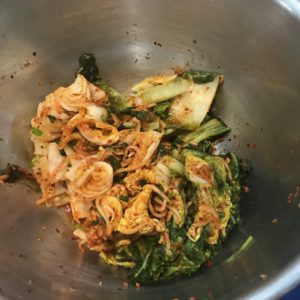 Preparing the Cabbage
Preparing the Cabbage
Wash cabbage. Remove any withered outer leaves and trim the root end. Cut through the root end about a quarter of the way up. With your hands, rip the cabbage in half the rest of the way. Repeat with each half so that you have four quarters. Put the cabbage in a large bowl and sprinkle the coarse salt evenly over the leaves. Make sure that some salt gets in between the larger, thicker leaves. Pour water over the cabbage, enough to cover. Place a large heavy object over the cabbages. Leave cabbage to soak at least six hours or overnight. After soaking, drain the cabbage and taste a leaf. If it is too salty, rinse under running water and let sit in a colander to drain.
Making the Seasoning Paste
While the cabbage is draining, prepare the other ingredients. Grind the shrimp, ginger, garlic, and onion (separately or together depending on the size of your mortar or food processor). Mix the ground ingredients with the fish sauce and red pepper flakes. Julienne the radish and mix with the other ingredients in the bowl. Then cut and add all the green ingredients (green onions, mustard, watercress, and chives). At this point, you probably want to use some kitchen gloves to avoid staining your hands. Korean housewives use the very thick red rubber gloves that go up to your elbow. If the mixture seems too dry, add one or two tablespoons of water.
Note: For vegan kimchi, omit the fish sauce and salted shrimp and add 4 teaspoons salt to the seasoning mixture.
Putting the Cabbage and Seasoning Together
In a large bowl, take one of the cabbage quarters and spread the seasoning paste between each layer of leaves, starting from the outermost leaf and working inward. Take care to leave every bit of cabbage red including the outside. Repeat for all the cabbage sections.
“Putting Down” Your Kimchi
Put all of the cabbage sections in a clean crock, glass jar, or stainless steel container. Position the cabbage sections with the cut sides down and folded over into neat packages, depending on the size of your container. If there is any seasoning paste left, put this on top of the cabbage in the container. Rinse out your bowl with up to one-quarter cup of water and pour on top of the kimchi. Push the cabbage down into your container to reduce air bubbles and to encourage the release of liquid from the vegetables. Leave at least two inches of headspace at the top of the container to avoid overflow when the kimchi starts fermenting. Cover the container loosely with plastic wrap or the lid of the container and put kimchi on a dish somewhere without direct sunlight.
Poggi kimchi can be eaten the same day it is made, but the flavor will develop and change over time. Leave the kimchi out for 24 hours (longer if the weather is cold and the fermentation has not developed or if you want your kimchi “ripe” right away) and then put the kimchi in the refrigerator. Once in the fridge, you can close the lid tightly as the initial fermentation will slow down.
Serving and Storing Your Kimchi
To serve poggi kimchi, take out a cabbage section and cut it into bite-sized pieces, making sure to cut off and discard the root end. (You probably want to use your kimchi gloves for this.) Push down the rest of the kimchi so all the vegetables are under the liquid. Kitchen scissors are a very easy way to cut up your kimchi. Serve with rice, soup, and banchan (side dishes) or invent your own kimchi dishes.
Kimchi can be kept for weeks in the refrigerator. During this time, the flavors will continue to develop, and the kimchi will get increasingly sour and sometimes even effervescent. If it gets too sour for your taste, you can cut it up and make a kimchi stew, kimchi pancakes, or kimchi fried rice with it. It is only “bad” when you see mold starting to grow on it.
Kimchi Pancakes (Kimchi Jeon)
By Hae Jung Cho, from the June 15, 2019 meeting
Ingredients
4 ounces chopped kimchi (liquid squeezed out)
2/3 cup all-purpose flour (or gluten-free flour)
1/2 cup water (or half water and half kimchi liquid)
1/2 teaspoon sugar
Vegetable oil for frying
Directions
Put flour, sugar and water in a bowl and whisk to mix. Mix in the kimchi. eat a large skillet and add some vegetable oil. Put half of the batter in the skillet and make about a 6-inch circle (about 1/4-inch thick). Cook over medium heat for about one minute or until the bottom turns brown. Using a spatula, flip the pancake over and then add more oil to avoid sticking. Continue cooking until both sides are golden brown or fully cooked. Make another pancake with the rest of the batter.
Yield: Two 6-inch pancakes, or several smaller.
Dipping Sauce
By Hae Jung Cho, from the June 15, 2019 meeting
Ingredients
2 tablespoons Korean or Japanese soy sauce or tamari
1 tablespoon water
1/2 teaspoons sesame oil
1 to 2 teaspoons sugar
1 clove garlic, minced
1 teaspoon Korean red pepper powder (gochu garu)
2 tablespoons lightly packed finely chopped green onion, white and green parts
2 to 3 teaspoons sesame seeds, toasted and crushed with a mortar and pestle
Directions
In a small bowl, stir together the soy sauce, water, sesame oil, and sugar, until the sugar has dissolved. Add the garlic, red pepper powder, green onion, and sesame seeds. Set aside for about 15 minutes for the flavors to develop. The sauce can be made in advance and refrigerated for up to a week. Right before using, taste the sauce again and adjust flavors.
Makes approximately 1/3 cup.
About the Culinary Historians of San Diego
Culinary Historians of San Diego (CHSD) is a nonprofit organization that provides the public with a history of food and drink and their roles in society, both locally and worldwide. Membership in this non-profit organization supports both CHSD activities and the culinary collection of the San Diego Public Library.
